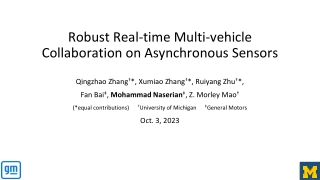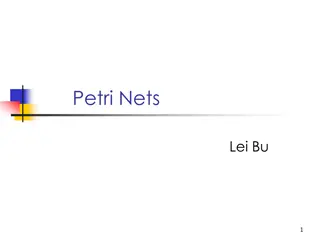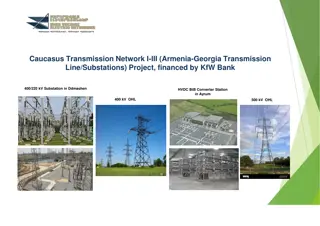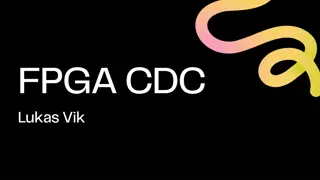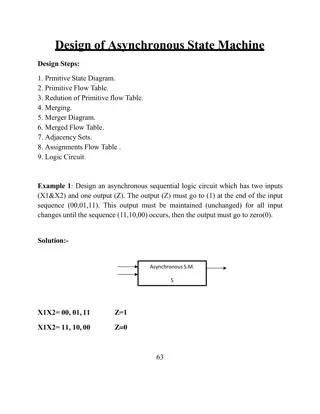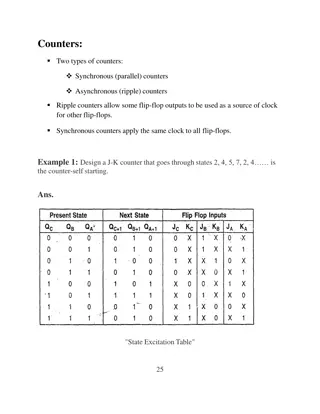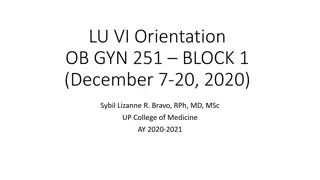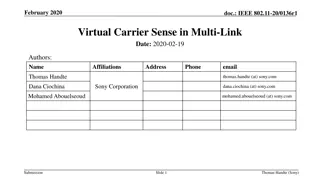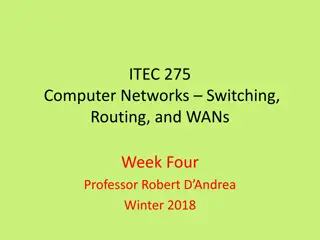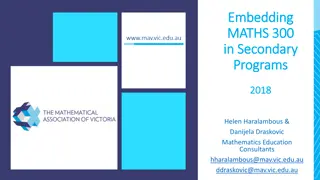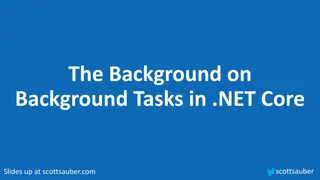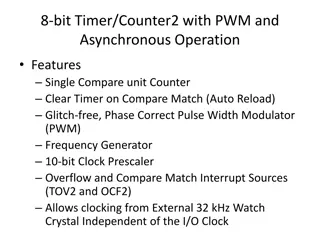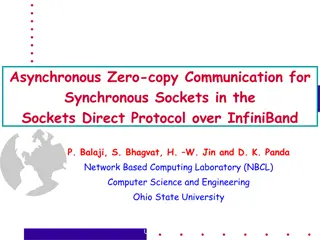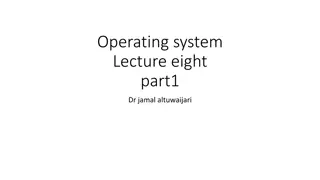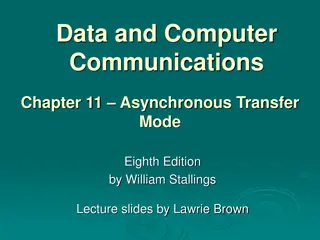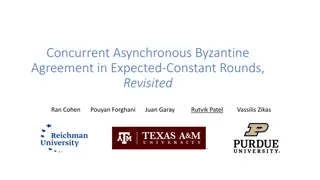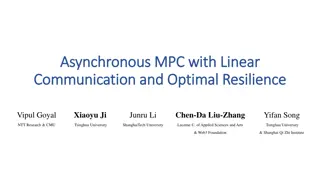Robust Real-time Multi-vehicle Collaboration on Asynchronous Sensors
A robust and real-time multi-vehicle collaboration system for asynchronous sensor data, addressing the synchronization problem and inaccurate blind spot estimation. The system leverages prediction algorithms for synchronization and enables on-demand data sharing for accurate blind spot estimation.
11 views • 12 slides
AI Applications in Dermatology - Advancements and Impacts
AI is revolutionizing dermatology through automated diagnosis, disease classification, treatment planning, and tele-dermatology. Initiatives like SkinVision and Miiskin PRO are utilizing AI to empower individuals in self-assessing skin spots and detecting skin cancer early. Interim updates include w
0 views • 7 slides
Understanding Petri Nets: A Versatile Tool for Modeling Systems
Petri nets are a powerful modeling tool characterized by their asynchronous state transitions, making them ideal for representing concurrent and distributed systems. Originating from Carl Adam Petri's work in the 1960s, Petri nets have found diverse applications in fields such as computer science an
1 views • 84 slides
Enhancing Learning with Swivl Recording Technology
Explore the innovative Swivl recording technology designed for asynchronous learning and professional development purposes. The Swivl Robot, along with Reflectivity software, provides secure video recording capabilities with options for live streaming and self-reflection. Learn how this technology c
1 views • 16 slides
Understanding Types of Tasks in Language Learning
Explore different types of tasks in language learning, including real-life tasks, pedagogic tasks, input-based tasks, output-based tasks, unfocused tasks, and focused tasks. Discover the language skills involved, types of outcomes students need to produce, and examples of task classifications.
2 views • 13 slides
Apache MINA: High-performance Network Applications Framework
Apache MINA is a robust framework for building high-performance network applications. With features like non-blocking I/O, event-driven architecture, and enhanced scalability, MINA provides a reliable platform for developing multipurpose infrastructure and networked applications. Its strengths lie i
3 views • 13 slides
Overview of Distributed Systems: Characteristics, Classification, Computation, Communication, and Fault Models
Characterizing Distributed Systems: Multiple autonomous computers with CPUs, memory, storage, and I/O paths, interconnected geographically, shared state, global invariants. Classifying Distributed Systems: Based on synchrony, communication medium, fault models like crash and Byzantine failures. Comp
9 views • 126 slides
Understanding Binary Counters and Types of Counters
Binary counters are registers used to count clock pulses, while binary counters follow the binary number sequence. There are two types of counters: serial/asynchronous counters and parallel/synchronous counters. Serial counters change output flip-flop to next flip-flop, requiring minimal hardware bu
12 views • 21 slides
Caucasus Transmission Network I-III Project Overview
The Caucasus Transmission Network I-III Project aims to establish an asynchronous power connection between Georgia and Armenia, fostering reliable cross-border energy exchange and regional integration within the South Caucasus countries. The project involves the construction of substations, transmis
1 views • 7 slides
Understanding Sequential Logic in NUS CS2100 Lecture #19
Explore the concepts of sequential logic in Lecture #19 by Aaron Tan at NUS, covering memory elements, latches, flip-flops, asynchronous inputs, synchronous sequential circuits, and different types of sequential circuits. Delve into the distinction between combinatorial and sequential circuits, memo
3 views • 26 slides
Advanced FPGA Design: Ensuring Safety, Reliability, and Predictability
With a background in MSc Applied Physics and 10 years of experience in FPGA development, the focus is on verifying asynchronous and analog aspects of FPGA design for safe, reliable, and robust performance. Limited resources and articles drive the need to collaborate for knowledge sharing and explori
0 views • 18 slides
Design of Asynchronous State Machine Steps and Example Circuit
Steps for designing an asynchronous state machine including primitive state diagram, flow table reduction, merging, adjacency sets, and flow table assignments. An example circuit design with S-R flip-flops for a specific sequential logic requirement is demonstrated.
0 views • 7 slides
Key Teaching Tasks and Partnerships in Assessment Framework
The assessment framework for teacher training programs must include a set of 10-15 key teaching tasks that new teachers should be capable of performing on their first day on the job. These tasks need to align with teaching standards, be observable and measurable, and connect directly to working with
1 views • 13 slides
Understanding Inter-Process Communication Signals in Operating Systems
Signals in inter-process communication are asynchronous notifications delivered to specific processes, allowing event-based programming. Processes can handle signal delivery by ignoring it, terminating, or invoking a signal handler. Signal handlers can be written in two ways - one handler for many s
0 views • 21 slides
Understanding Synchronous and Asynchronous Counters in Digital Electronics
Explore the concepts of synchronous (parallel) and asynchronous (ripple) counters in digital electronics, where ripple counters enable clock sharing among flip-flops and synchronous counters apply the same clock to all. Learn to design J-K and up-down counters using flip-flops with examples and stat
1 views • 4 slides
OB-GYN 251 Block 1 Activities & Schedule Overview
Activities for Block 1 include small group discussions on OB and GYN topics, infographics creation, department conferences, asynchronous learning activities, and an online examination. The schedule consists of various meetings, conferences, learning tasks, and an end-of-rotation exam. Weekly summari
0 views • 9 slides
Distributed Algorithms for Leader Election in Anonymous Systems
Distributed algorithms play a crucial role in leader election within anonymous systems where nodes lack unique identifiers. The content discusses the challenges and impossibility results of deterministic leader election in such systems. It explains synchronous and asynchronous distributed algorithms
2 views • 11 slides
Guide to Dealing with Asynchronous World in Game Development
Dive into the world of dealing with asynchronous tasks in game development, exploring topics like shifting responsibilities, queuing strategies, and basic hints for efficient handling. Understand the complexities involved in managing CPU and GPU interactions, optimizing performance, and structuring
0 views • 27 slides
Virtual Carrier Sense in Asynchronous Multi-Link Networks
Exploring the implementation of virtual carrier sense in asynchronous multi-link networks based on IEEE 802.11 standards. The presentation discusses the benefits of using NAV (Network Allocation Vector) in asynchronous multi-link setups to avoid hidden node issues, improve throughput, and latency. I
0 views • 16 slides
Virtual Carrier Sense in Multi-Link Networks
This document discusses the implementation and advantages of virtual carrier sense in multi-link networks under the IEEE 802.11 standard. It explores the operation of multi-link setups, asynchronous communication benefits, and the necessity of multiple contention channels. The concept of NAV (Networ
2 views • 11 slides
Computer Networks and WANs: Week Four Overview
This week's session covers VMware View Client commands, traffic flow device configurations, Asynchronous Transfer Mode (ATM), Quality of Service (QoS), and more. Explore hands-on activities in MIMIC Virtual Lab CCNA and learn essential commands for networking tasks like configuring interfaces, debug
0 views • 70 slides
Understanding Rich Tasks in Mathematics Education
Rich tasks in mathematics education are purposeful and engaging activities that encourage problem-solving, critical thinking, and collaboration among students. These tasks are designed to challenge learners at different levels, promote multiple solution strategies, and lead to meaningful learning ou
0 views • 20 slides
Performance Aspects of Multi-link Operations in IEEE 802.11-19/1291r0
This document explores the performance aspects, benefits, and assumptions of multi-link operations in IEEE 802.11-19/1291r0. It discusses the motivation for multi-link operation in new wireless devices, potential throughput gains, classification of multi-link capabilities, and operation modes. The s
0 views • 30 slides
Performance Aspects of Multi-link Operations in IEEE 802.11-19/1291r3
This document discusses the motivation, assumptions, and classifications related to multi-link operations in IEEE 802.11-19/1291r3 standard. It explores the benefits of multi-link capabilities in new wireless devices, such as improved throughput, reduced latency, and potential for link aggregation.
0 views • 18 slides
Embracing Secondary School: Weekly Tasks for Year 7 Students
As Year 7 students transition to secondary school, weekly tasks aim to build confidence, resilience, and a positive attitude. Tasks include unlocking the mind-set, addressing worries, and challenging self-limiting beliefs through a growth mindset. Encouraging students to develop a positive approach
0 views • 5 slides
Clear Approach to Cancellation of Asynchronous Operations
This resource discusses the concept of cancellation primitives, providing a clear and consistent approach to cancelling asynchronous operations. It emphasizes separating the source and sink, enabling synchronous and asynchronous observation of cancellation requests. The goal is to facilitate composa
0 views • 17 slides
Understanding Background Tasks in .NET Core
Explore the world of background tasks in .NET Core with this informative slideshow by scottsauber. Learn about various types of background tasks, suitable problems, available options like IHostedService, BackgroundService, Worker Service, Hangfire, and more. Discover how to choose the right option f
0 views • 41 slides
Understanding Interrupts and Timers in Microcontrollers
Microprocessors function as finite state machines, with instructions loaded from memory and executed in sequence. However, interrupts allow for urgent out-of-turn servicing of signals, providing a way to handle asynchronous events. Learn how to utilize interrupts efficiently with examples on Arduino
0 views • 9 slides
8-bit Timer/Counter2 with PWM and Asynchronous Operation
The 8-bit Timer/Counter2 with PWM and Asynchronous Operation features single compare unit, glitch-free operation, phase-correct PWM, frequency generator, clock prescaler, interrupt sources, and external clocking options. It includes registers for control, counter, output compare, asynchronous status
0 views • 14 slides
Challenges and Innovations in CXL 3.0 Dynamic Capacity Devices
Exploring the intricacies of CXL 3.0 Dynamic Capacity Devices presented at the LPC CXL micro conference 2023, focusing on asynchronous memory operations, partial extents, interleaving flow challenges, and memory sharing. The discussion delves into the dynamic capacity feature allowing memory changes
0 views • 17 slides
Comprehensive Health and Social Care Year 12 Preparation Tasks
This set of tasks aims to prepare students for Year 12 studies in Health and Social Care. Tasks include creating lists of settings and professions, crafting job adverts for healthcare and social care workers, researching and creating an academic poster on equality, diversity, and rights, visiting va
0 views • 8 slides
Asynchronous Zero-copy Communication in Sockets Direct Protocol over InfiniBand
This study explores the implementation of Asynchronous Zero-copy Communication for Synchronous Sockets in the Sockets Direct Protocol over InfiniBand. It discusses InfiniBand's high performance, low latency, and advanced features, as well as the Sockets Direct Protocol as a high-performance alternat
0 views • 36 slides
Enhancing Student Engagement with Flip in Asynchronous Online Classes
Explore the use of Flip for student engagement in asynchronous online classes through real student feedback and examples. Learn how Flip encourages interaction and collaboration, making online learning more dynamic and engaging for students. Discover various ways to use Flip for assignments, discuss
0 views • 15 slides
Understanding Asynchronous and Concurrent Processes in Operating Systems
Exploring the concepts of asynchronous and concurrent processes in operating systems, this lecture covers how processes can function independently or require occasional synchronization. It also delves into parallel processing complexities, control structures for indicating parallelism, precedence gr
0 views • 14 slides
Understanding Asynchronous Transfer Mode (ATM) in Data and Computer Communications
Asynchronous Transfer Mode (ATM) is a packet transfer technology that supports multiple logical connections over a single physical interface. It uses fixed-sized packets called cells for data transfer. ATM bears similarities to packet switching and offers streamlined packet transfer with minimal err
0 views • 46 slides
Optimally Resilient Asynchronous Multi-Valued Byzantine Agreement
Exploring the challenges and solutions in achieving optimally resilient asynchronous multi-valued Byzantine agreement protocols. This work presents a novel construction meeting key requirements and delves into round-preserving parallel composition of agreements, shedding light on probabilistic termi
0 views • 19 slides
Understanding Holistic Assessment Tasks in Education
Holistic assessment tasks in education aim to assess students' learning across various areas of development, incorporating higher-order thinking skills and application in real-world contexts. These tasks are used for pre-assessment, ongoing learning, and making professional judgments of achievement
0 views • 14 slides
Hire Node.js Developers Like a Pro Strategies for Finding the Best Talent
This means that Node.js has been quickly gaining prominence as the most used server-side framework with the rise of highly dependent businesses on dynamic and efficient web applications. Easy handling of high-performance applications, including asynchronous tasks, explains why companies are eager to
0 views • 6 slides
Overview of Asynchronous MPC with Linear Communication and Optimal Resilience
Explore the concepts of Asynchronous Multiparty Computation (MPC) with Linear Communication and Optimal Resilience, discussing the model, motivation, and differences between synchronous and asynchronous protocols. The goal is to ensure correctness and privacy in a setting where parties may be corrup
0 views • 72 slides
Streamlining Milestone Award Tasks in Workday for Efficient Grant Management
Simplify the process of completing milestone award tasks in Workday by following step-by-step instructions. Learn how to navigate to award tasks, complete award tasks, and find valuable resources for grant management. Contact GCA for assistance when needed.
0 views • 6 slides
